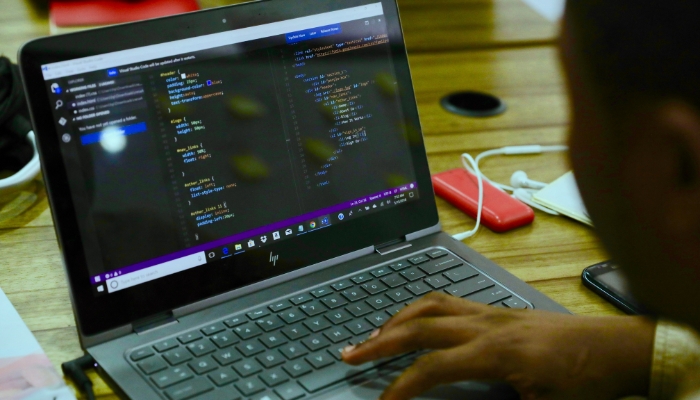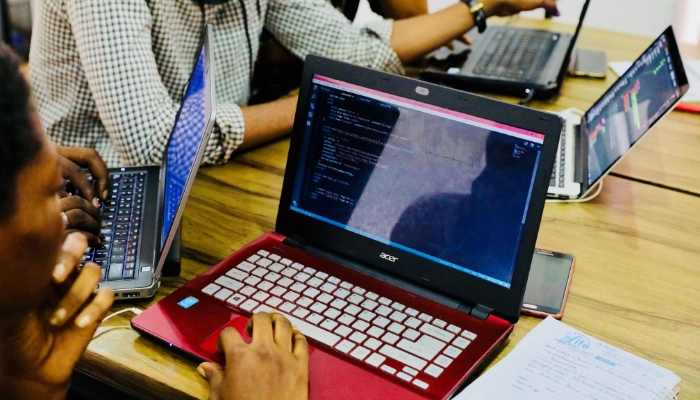
You’re online daily, right? Surfing, shopping, chatting – it’s a digital world. But with this convenience comes risk – cyber crime. Ever thought about how to prevent cyber crime?
Online threats are real and it’s crucial you understand how to protect yourself. From establishing rock-solid passwords to securing your transactions, you’ve got to be proactive.
To prevent cyber crime, it’s essential to use strong, unique passwords, keep software updated, and install protective software like antivirus programs. Regular data backups and education on recognizing and reporting suspicious activities are also crucial.
Let’s delve into cyber crime basics, explore why strong passwords matter, discuss safe online transactions, and look at the benefits of regular software updates.
Table of contents
Understanding Cyber Crime Basics
Before diving into methods of prevention, it’s crucial you grasp the fundamentals of cyber crime. Understanding cyber crime basics isn’t just about knowing definitions, it involves comprehending the types of cyber threats and the motivations behind them.
Cyber crime, in its simplest form, is any illegal activity that involves a computer or network. It can range from identity theft, to hacking, to cyberbullying. To prevent cyber crime, you need to take basic security steps, like setting strong passwords and updating software regularly. However, prevention also involves staying informed about the latest scams and hacking methods.
Importance of Strong Passwords
In the realm of cyber security, it’s essential that you set strong, complex passwords for all your accounts to shield yourself from potential cyber threats. Default or weak passwords can be easily guessed or cracked, making you vulnerable to data theft and other cyber crimes, including cyberbullying, which leads many to ask, ‘Is cyber bullying illegal?
To ensure that you have secure passwords, consider these four suggestions:
- Create unique passwords for each account.
- Use a mix of characters, including uppercase, lowercase, numbers, and symbols.
- Avoid using personal information in your passwords.
- Use a password manager to securely store and manage your passwords.
Remember, strong passwords are your first line of defense against cyber threats. Now, let’s move on to securing your online transactions.
Securing Your Online Transactions

Beyond setting strong passwords, you’ll need to secure your online transactions to further shield yourself from cyber criminals. When dealing with financial institution websites or managing your bank accounts online, it’s crucial to ensure that the site is secure. Look for the ‘https’ prefix in the URL, indicating that the website uses encryption to protect your data.
Another security measure is to avoid public Wi-Fi networks when conducting transactions, as these can be easy targets for cyber criminals. Regularly monitor your online accounts for any suspicious activities. Remember, your online security relies on your vigilance and commitment to protecting your personal information.
Now, let’s delve deeper into another essential aspect of securing your online presence: implementing two-factor authentication.
Implementing Two-Factor Authentication
As an added safeguard, you’ll want to consider implementing two-factor authentication for all your online accounts. This method, also known as dual-factor authentication, adds an extra layer of security that goes beyond your typical username and password.
- Two-factor authentication requires two different forms of identification, making it tougher for cybercriminals to breach your account.
- Multi-factor authentication takes this a step further, incorporating three or more verification methods.
- The use of additional authentication measures, like biometrics or an authentication application, can further enhance your online safety.
- Pairing anti-virus and two-factor authentication can fortify your defenses against cyber threats.
By implementing these measures, you’re significantly reducing your exposure to cybercrime. Now, let’s move on to the importance of regular software updates and maintenance.
Regular Software Updates and Maintenance
Along with employing two-factor authentication, keeping your software updated is another crucial step in shoring up your defense against cybercrime. Regular software updates and maintenance aren’t just about adding new features or improving functionality. They’re essential to prevent cyber crime. These updates often include patches for security vulnerabilities that hackers can exploit.
You should prioritize updating your antivirus software and security software. These programs are your frontline defense, providing malware protection that can detect and neutralize threats. But, their efficacy depends on being current with the latest virus definitions and threat profiles.
Advanced Protective Strategies

In the digital era, where cybersecurity threats are as common as they are diverse, implementing advanced protective strategies is not just a recommendation; it’s a necessity. These strategies are the bulwark against a spectrum of malicious activity, safeguarding personal, corporate, and national security settings.
Data Encryption Techniques
Data encryption techniques stand at the forefront of protecting sensitive information. Whether it’s personal social security details or company databases, encryption acts as an indecipherable shield against unauthorized access.
It’s a complex array of activities that transforms readable data into a coded form, which can only be accessed with the right key. This is particularly crucial for mobile devices, which are often the weak link in security controls due to their portability and the high risk of theft or loss.
Use of Web Application Firewalls (WAF)
Web Application Firewalls (WAF) are specialized internet security software designed to filter, monitor, and block malicious links and traffic to and from a web application. A robust WAF helps protect web applications by filtering and monitoring HTTP traffic between a web application and the Internet.
It typically protects web applications from attacks such as cross-site forgery, cross-site-scripting (XSS), file inclusion, and SQL injection, among others. By deploying a WAF in front of a web application, a shield is put in place that secures the application from online harassment and ransomware attacks.
Secure Wi-Fi and Network Practices
In today’s interconnected world, secure Wi-Fi and network practices are essential. This includes the use of Virtual Private Networks (VPN) to ensure a private network connection, safeguarding data as it travels across public networks.
Organizations must enforce a strong password policy, moving away from default passwords and encouraging the use of complex, unique passwords. Internet network secure protocols like WPA3 should be implemented to enhance Wi-Fi security, reducing the risk of network intrusion.
Email Security and Phishing Awareness
Email security is a critical component of any cybersecurity strategy. Unsolicited emails and attachments in spam emails are common methods used by bad actors to deploy malicious software. Educating employees about the dangers of phishing attacks, often a focus area for cyber investigators, where suspicious links in emails masquerade as legitimate requests, is vital. Phishing awareness programs can significantly reduce the risk of employees inadvertently providing access to company computers or company devices.
Adaptive authentication methods, such as two-factor authentication, add an additional protection layer, ensuring that even if an email address is compromised, the criminal activity is halted before causing significant damage. Anti-virus software, like Kaspersky Total Security, can provide all-in-one protection against various forms of malware attacks, including those that might slip through via spam email.
In conclusion, the fight against cybercrime is an ongoing battle that requires a combination of advanced protective strategies. From data encryption techniques to adaptive authentication and phishing awareness, each layer of defense plays a crucial role in maintaining cyber safety. As cybersecurity companies continue to innovate and provide bespoke tools and solutions, organizations and individuals must stay informed and vigilant, adapting their defenses to the ever-evolving landscape of cybersecurity threats.
Future of Cyber Crime Prevention

The future of preventing cyber crime is closely tied to the rise of new technologies. As we develop smarter tools, so too do we enhance our defenses against digital threats.
Emerging Technologies and Their Impact
Emerging technologies are changing the game in cyber crime prevention. For example, artificial intelligence (AI) is not just a buzzword; it’s a powerful ally. AI can analyze patterns and detect anomalies that might suggest a cyber attack.
This means we can stop criminals in their tracks before they do any harm. Similarly, the growth of internet of things (IoT) devices expands our connected world, but it also requires us to be smarter about securing these devices to prevent unauthorized access.
Predictive Analytics and AI in Cyber Security
Predictive analytics and AI are like the crystal ball of cyber security. They can predict potential cybersecurity threats by looking at past incidents and current trends.
This foresight allows companies to prepare and protect themselves against future attacks. AI systems learn from malicious activity, making them better at spotting malicious software and phishing attacks.
The Evolving Landscape of Cyber Threats
As technology evolves, so do the threats. Cyber criminals, in particular, are always finding new ways to exploit vulnerabilities, whether through social engineering or more sophisticated malware attacks. But as we develop adaptive authentication methods and smarter security controls, we’re building a tougher barrier to breach.
In short, the future of cyber crime prevention is proactive, not reactive. It’s about using emerging technologies to stay one step ahead. With AI and predictive analytics on our side, we’re turning the tide against cyber criminals. The key is to keep adapting and stay vigilant because the landscape of cyber threats is always changing.
Conclusion
In conclusion, you’re not powerless against cyber crime. By understanding its basics, you can make smarter choices online. Strong passwords and secure transactions are crucial, while two-factor authentication adds an extra layer of defense.
Regular software updates and maintenance are also key. Be proactive in your approach, stay vigilant and remember, prevention is always better than cure when it comes to cyber crime. You’re in control of your own cyber security.
FAQs
Is it important to prevent cybercrime?
Absolutely. Preventing cybercrime is crucial because it protects us from identity theft, financial loss, and threats to our personal and national security. It ensures our digital world is safe and trustworthy.
How can individuals contribute to preventing cybercrime?
Individuals can contribute by using strong, unique passwords, enabling two-factor authentication, and being cautious of suspicious links and emails. Keeping software updated and using reputable anti-virus software also go a long way.
How effective are firewalls in preventing cybercrime?
Firewalls are very effective as a first line of defense. They act as a barrier between your computer and the internet, controlling the incoming and outgoing network traffic and blocking malicious software and unauthorized access.
Can cybercrime be completely eradicated?
Completely eradicating cybercrime is challenging due to the constantly evolving nature of technology and human ingenuity. However, with continuous advancements in cyber safety measures and public awareness, we can significantly reduce its prevalence and impact.